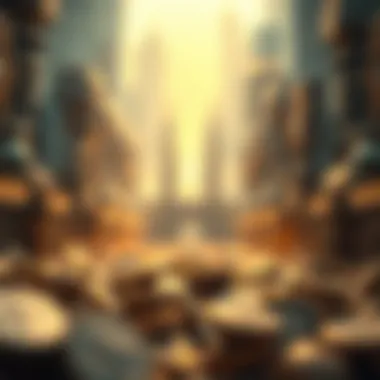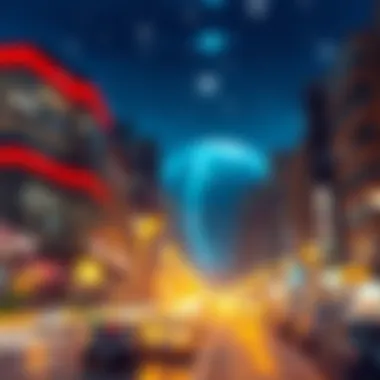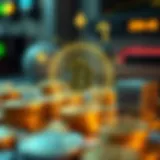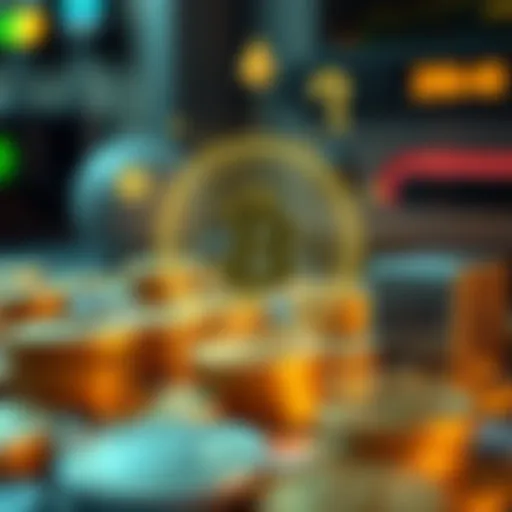Understanding NFT Pieces in the Digital Art Landscape


Intro
The rise of digital art has changed the landscape significantly, and with it, the emergence of NFT pieces has garnered considerable interest. These non-fungible tokens represent artwork in a digital format, allowing artists and collectors to engage in unique, groundbreaking transactions. Understanding this phenomenon is essential, particularly for investors, tech experts, and enthusiasts alike, as NFTs bridge art and technology in unprecedented ways.
In this article, we will navigate through the intricate world of NFT pieces, exploring their implications not just within the digital art sphere, but also throughout the broader blockchain ecosystem. We aim to dissect the technical foundations, the roles of market dynamics, and the ongoing cultural conversations that surround these distinct digital assets. By the end, readers will possess a comprehensive understanding of NFT pieces, their current significance, and what the future might hold for them.
As we dive deeper, let's break down some essential crypto fundamentals that serve as the underpinnings of NFTs and their place in the art world.
Prelims to NFTs
In the unfolding narrative of digital art, Non-Fungible Tokens (NFTs) have leapt into the spotlight, reshaping how we perceive, create, and engage with art. The introduction of NFTs represents more than a mere technological advancement; it signifies a seismic shift in ownership and authenticity in the digital age. These unique digital assets hold intrinsic value and potential that artists and collectors alike have begun to appreciate and explore.
NFTs bridge the gap between the traditional art world and the burgeoning digital landscape, providing artists with new avenues to monetize their work while granting buyers a form of ownership that is both verifiable and secure. As we delve deeper into various aspects of NFTs, it is crucial to grasp not only their mechanics but also their implications on creative expression, market trends, and cultural paradigms.
Understanding NFTs involves recognizing that they are not merely a trend or a passing fad but a fundamental evolution of how art is generated, collected, and appreciated. As we navigate through this complex waterscape, we will unpack the critical elements, benefits, and considerations that lie within the realm of NFTs, establishing a clear context for their transformative impact on digital creativity.
What are NFTs?
NFTs, or Non-Fungible Tokens, are digital tokens that represent ownership of a unique item or piece of content, often linked to visual art, music, videos, or virtual assets. Unlike cryptocurrencies such as Bitcoin or Ethereum, which are fungible and can be exchanged one-for-one, NFTs carry distinct values tied to the specific assets they represent. Each NFT contains unique information or attributes that make it one-of-a-kind, ensuring that even digitally replicated items retain a sense of exclusivity.
The functionality of NFTs hinges on blockchain technology, which offers a decentralized and transparent ledger for recording ownership and transaction history. As a result, buyers can verify the authenticity and provenance of an NFT, an essential factor given the potential for digital art to be easily copied or plagiarized. This embodies the core idea that NFTs not only enhance digital ownership but also protect creators’ rights in a way that was previously unattainable in the online sphere.
The concept of ownership is evolving rapidly; NFTs are at the forefront of this transformation, crafting new pathways for artists and audiences alike.
Historical Context of NFTs
To fully grasp the significance of NFTs in contemporary digital art, we must look back at their origins. The journey of NFTs began in the early 2010s with the advent of blockchain technology and the burgeoning interest in cryptocurrencies. While the idea of digital ownership was floating around in various forms, it wasn’t until 2017 that NFTs truly began to gain traction in the mainstream.
The launch of platforms like CryptoPunks and CryptoKitties marked a watershed moment, demonstrating how unique digital assets could be created, bought, and sold on an open marketplace. CryptoKitties, in particular, enabled users to breed and trade virtual cats, making the concept of collectible digital items accessible to the general public. This sparked a frenzy and laid the groundwork for the flourishing NFT ecosystem we see today.
Since then, notable sales such as Beeple’s "Everydays: The First 5000 Days" — which sold for a staggering $69 million — catapulted digital art into an arena previously dominated by traditional mediums, pushing the art market into previously uncharted territories. The evolution of NFTs has earned them a spot not just in art galleries and exhibitions but also in discussions about intellectual property, copyright, and valuation, paving the way for the future of art as we know it.
The Technology Behind NFT Pieces
The technology that underpins NFT pieces forms the backbone of their function and success in the digital art landscape. Understanding this technology is crucial for investors, artists, and enthusiasts alike. In essence, NFTs represent a revolutionary approach to ownership, leveraging specific technologies that enhance their uniqueness and scarcity.
Blockchain Fundamentals
At the very core of NFTs is blockchain technology. This decentralized ledger system records transactions across multiple computers so that the recorded transactions cannot be altered retroactively. This serves two main functions: it provides an irrefutable proof of ownership and ensures the authenticity of digital assets.
Key Features of Blockchain in NFTs:
- Transparency: All transactions are viewable on the blockchain. This means anyone can verify the ownership and provenance of an NFT.
- Security: The decentralized nature of blockchain enhances the security of NFTs against fraud. Once created, an NFT cannot be easily duplicated or modified, making it a safe item to invest in.
- Smart Ownership: Ownership is defined on the blockchain, allowing for seamless transfer of art pieces without the complexities involved in traditional transactions.
Using Ethereum as an example, the most common blockchain for NFTs, it employs the ERC-721 standard, which defines how to create and manage NFTs. Each token created under this standard is unique, compared to fungible tokens like Ether, which are interchangeable.
"The essence of blockchain means you truly own your digital assets, unlike ever before."
Smart Contracts Explained
Another important component of NFT technology is smart contracts. These are self-executing contracts with the agreement directly written into code. Smart contracts automatically enforce the terms based on logical conditions, eliminating the need for intermediaries.


Benefits of Smart Contracts in NFTs:
- Automatic Transfer: Upon purchase, the smart contract automates the transfer of ownership, making the transaction quick and efficient.
- Royalty Agreements: Artists can embed royalty agreements within the smart contract, ensuring they receive a percentage of future sales. This promotes long-term revenue for creators rather than a one-off payment.
- Immutable and Secure: Once written and deployed, smart contracts cannot be changed unless agreed upon by the parties involved, ensuring honesty and integrity in transactions.
Understanding these technological foundations helps demystify how NFT pieces function in the digital realm, paving the way for informed engagement in the NFT marketplace. As collectors and investors become more aware of these elements, their confidence in this evolving technological landscape grows.
Creating an NFT Piece
Creating an NFT piece represents a significant intersection of creativity and technology in the digital landscape. Understanding how to craft these unique digital assets is crucial for artists and collectors alike. The process not only opens up avenues of financial gain but also elevates the way art is perceived and traded today.
When one talks about creating an NFT, it is essential to consider several key elements: the artistic vision behind the piece, the choice of platform for minting, and the understanding of potential marketplaces where the NFT will be showcased. As the saying goes, "You gotta know the ropes before you can climb the ladder." This holds true for NFT creators. They must understand what appeals to collectors and how to position their work appropriately.
The Art of Minting
Minting an NFT involves the process of creating a unique token that represents a digital item. It’s akin to casting a sculpture in bronze; once the mold is ready, you pour in the metal to create a lasting and exclusive piece. Similarly, during minting, artists upload their digital artwork to a blockchain, typically Ethereum, where it becomes verifiable and traceable.
The importance of the minting process cannot be understated; it validates the item as a true NFT and ensures that the artist maintains ownership. This is where the concept of rarity comes into play. Depending on the platform used, an artist can opt to mint a one-of-a-kind piece or a collection with limited copies.
Key Steps in Minting:
- Select your artwork: This could be anything from digital paintings, music, videos, or even tweets.
- Choose a minting platform: Platforms like OpenSea, Rarible, or Mintable have distinct features and fee structures. It’s essential to do your research and select the right fit for your needs.
- Create a digital wallet: A secure digital wallet is required to hold your NFTs and cryptocurrencies.
- Connect the wallet to the chosen platform: This usually involves a few clicks and necessary confirmations.
- Upload the artwork: Here, you provide information about the piece, including description, attributes, and a price.
Minting is pivotal not only for securing the digital artwork but also for building an audience, as potential buyers will often seek pieces that come with verifiable authenticity.
Choosing the Right Marketplace
Once the artwork is minted, the next step is deciding where to sell it. This step can be likened to finding the right stage for a performance; the more suitable the venue, the more likely the audience will appreciate the act. Each marketplace caters to different types of buyers and collectors, which can influence the success of NFT sales.
Factors to consider when choosing a marketplace:
- Fees: Each platform has its own fee structure, which can include minting costs, listing fees, and transaction fees. Understanding these costs upfront can prevent unpleasant surprises later.
- User base: The more active users a marketplace has, the greater the exposure your NFT is likely to receive. Platforms like OpenSea and Rarible often have a larger pool of buyers.
- Features and tools: Some marketplaces offer enhanced features like auctioning capabilities, fractional ownership, or enhanced social sharing tools. It would be wise to explore these options and utilize them to your advantage.
- Community: Marketplaces that foster a strong community can be beneficial for artists looking to gain recognition and build networks. Evaluating community engagement and support can guide the right selection.
In summary, creating an NFT piece is not just about the technological process; it’s about strategically positioning oneself within the digital art ecosystem. The careful balance of artistry, technology, and market awareness is crucial for success.
Valuation of NFT Pieces
The valuation of NFT pieces stands as a pivotal discussion in understanding their role within the digital art world. As more artists and collectors dive into the NFT space, the ability to determine the worth of these digital assets becomes increasingly essential. Valuation affects not only the financial dynamics of buying and selling but also influences perceptions around artistic merit, ownership, and digital scarcity.
In essence, valuation acts as a compass, guiding investors, artists, and enthusiasts through the ever-evolving landscape of digital art. It sheds light on the factors that contribute to a piece's worth, which can fluctuate significantly based on market conditions, popularity, and technological advancements. By grasping the nuances of NFT valuation, participants in the market can make informed decisions that align with their interests and goals.
Factors Affecting Valuation
A variety of elements come into play when assigning value to an NFT. Here are some key factors:
- Artist Reputation: Like any traditional art market, the stature of the artist can significantly influence the price. Established artists may command higher prices than newcomers, simply due to recognition.
- Rarity and Scarcity: The uniqueness of the NFT, such as limited editions or one-of-a-kind pieces, can spike interest and subsequent valuations. Scarcity often fuels demand, leading collectors to invest more for rare finds.
- Technical Quality: The underlying technology, including the quality of the artwork and the execution of the minting process, can also affect valuation. Digital pieces that employ advanced techniques or creative approaches typically fetch higher prices.
- Cultural Relevance: A piece that resonates with current societal trends or cultural movements may see an increase in demand. For instance, NFTs that comment on pressing social issues or that participate in movements such as digital identity could attract a broader audience.
- Historical Significance: The first of anything tends to garner attention. NFTs that mark significant moments in digital art history will often hold a special place in collectors' hearts and wallets, driving up their valuations.
Understanding these factors can help investors grasp the complex web of influences that dictate NFT prices.
Market Trends and Sales Data
To navigate the intricacies of NFT valuation, it's critical to engage with current market trends and sales data. Monitoring platforms like OpenSea, Rarible, or Foundation helps gain insights into the ever-shifting landscape.


- Sales Volume: Examining the overall sales volume can indicate the fervor or lack of interest in certain NFT categories. Spike in sales often correlates with art movements or technological innovations in the space.
- Price Fluctuations: Watching how prices of similar pieces change over time informs investors about potential future trends. For example, a recent surge in the value of generative art pieces showcases how a niche suddenly attracts widespread attention.
- Collector Profile: Insights into who is buying—not just what—is equally vital. A collector backed by significant capital can inflate prices, which might not reflect broader market sentiment.
- Auction Dynamics: NFT auctions often reveal underlying demand; high-stakes bidding for particular pieces indicates increased interest. Keeping track of auction results can help predict future valuations.
In synthesizing this wealth of information, one gains a clearer perspective on how to assess NFTs within the market's larger context, thereby making better investment choices.
Resources:
In summary, the valuation of NFT pieces encompasses a blend of both subjective and objective factors, influenced by a rapidly changing market influenced by tech trends, cultural moments, and the inherent unpredictability of art.
Cultural Impact of NFT Pieces
The advent of NFT pieces has stirred significant shifts in the art world and also in the cultural fabric surrounding digital creation. This impact can be perceived through multiple lenses, one of which is the redefinition of ownership in the digital age. Unlike traditional artworks that reside in physical spaces, NFTs allow digital art to possess unique identities backed by the immutability of blockchain technology. The idea that one can own a digital work, often at the click of a button, is both thrilling and somewhat bewildering.
Redefining Ownership in the Digital Age
In the past, the concept of ownership was straightforward: a person held a physical artwork, touching, admiring, and sometimes displaying it. The emergence of NFT pieces challenges this simplistically view. Digital assets like artwork can be copied effortlessly; yet, NFTs provide a solution—asserting uniqueness and ownership. When someone purchases an NFT, they acquire a link to a specific digital asset secured on the blockchain, distinguishing it from mere file duplicates.
The cultural ramifications of this shift are profound. Artists now have the ability to sell their work globally without the confines of traditional gallery spaces. Many emerging artists find themselves with unprecedented access to collectors and communities around the world. This change democratizes art ownership, potentially leading to a more decentralized and diverse art market. Moreover, the ownership of NFT pieces can provide a new level of engagement between artists and their audience. Artists can embed royalties into their smart contracts, ensuring they benefit from future sales as well; this completely reshapes the way artists view their work and interactions with collectors.
"NFTs create a digital provenance that ensures creators can retain value in their work long after the initial sale."
NFTs and the Evolution of Art
The evolution of art through NFTs is not merely a function of technology but also a reflection of cultural values. Traditionally, art has often been an elite domain, reserved for those who possess the financial means to invest in tangible forms. However, NFTs invite a new generation of creators and enthusiasts into the fold. The burgeoning NFT market has given rise to virtual galleries and exhibitions, where art can thrive outside conventional parameters.
One aspect worth mentioning is how NFTs promote innovative forms of expression. Artists like Beeple have transformed digital canvases into records of immense financial success, selling pieces for millions. This new economy is reshaping what is deemed valuable, challenging long-held assumptions about physicality and scarcity in art.
Additionally, cultural narratives surrounding NFTs are rapidly changing. Many creators utilize platforms such as Twitter and Discord to engage directly with their supporters, fostering a strong community around their work. This community aspect is vital, embedding social value into the NFT landscape that transcends mere ownership.
In summary, the cultural impact of NFT pieces goes beyond the transactional. It urges us to rethink notions of ownership, accessibility, and community within the arts. Artists and collectors alike are navigating this new terrain, leading to an evolution that is as exciting as it is complex.
Investing in NFT Pieces
In recent times, the digital landscape has witnessed a surge of interest in Non-Fungible Tokens (NFTs), particularly within the realm of art and collectibles. Investing in NFT pieces has grown from a niche market to a significant avenue for both art enthusiasts and financial strategists. It’s not just about owning a piece of digital art; it’s this new frontier combining creativity, technology, and finance that makes this topic vital for anyone concerned with the evolving economy of art.
The allure of NFTs lies in their unique characteristics. Unlike standard cryptocurrencies, NFTs represent ownership of a specific digital item, making each piece distinct. As the technologies behind them continue to mature, they not only facilitate trade but also set the stage for new models of ownership and value creation in art. For collectors and investors alike, understanding this evolution is crucial.
Strategies for Investors
Investing in NFT pieces is not simply about luck; it requires insightful strategies and a keen eye for potential. Here are some approaches that can guide investors:
- Research: Identification of Worthy Projects
In a market flooded with options, discerning which projects hold long-term value is imperative. Look for artists with a strong track record and communities that support their work. - Building a Diverse Portfolio
Just like traditional investing, diversifying one’s NFT collection can mitigate risks. Instead of banking on a singular piece, consider acquiring various NFTs across genres and price points. - Engagement with the Community
Active participation in NFT communities can provide valuable insights. Platforms like Discord and Reddit are not just social networks; they’re vital for gathering information about upcoming projects and understanding market sentiment. - Timing the Market
Understanding market trends is essential, including the best times to buy or sell. Keeping an eye on fluctuations and being aware of seasonal trends can provide a competitive edge.
Risk Analysis and Considerations
Like any investment, buying NFTs comes with inherent risks. A comprehensive risk analysis is vital to safeguard your financial interests. Here are a few considerations:
- Market Volatility
The NFT market is notorious for its instability; values can skyrocket or plummet in the blink of an eye. Investors should be prepared for fluctuations and possibly plan for long-term holding. - Intellectual Property Issues
Some digital assets may come with unclear ownership rights. It’s crucial to ensure that the NFT purchased grants the rights you expect. An understanding of intellectual property laws in the context of digital art is necessary. - Historical Trends
Analyzing previous market trends can be enlightening, yet the NFT market moves quicker than many sectors. Remember, past performance is not always indicative of future results. - Technology Risks
As the landscape shifts, new technology can bring uncertainty. Cybersecurity threats and the potential for platforms to become obsolete or malfunction pose risks that need to be mitigated.
Investing in NFT pieces is a complex endeavor marked by both exciting opportunities and formidable challenges. Close attention to strategies and risks will prepare investors to navigate this innovative yet unpredictable market effectively.


Legal and Regulatory Considerations
Navigating the landscape of NFTs offers a myriad of exciting opportunities but also comes with a fair share of legal hurdles. As the digital art world increasingly intertwines with blockchain technology, understanding the legal frameworks surrounding NFTs becomes crucial. This section will explore the intricacies of intellectual property rights and the regulations affecting NFT sales, shedding light on how creators and consumers can approach these issues wisely.
Intellectual Property Rights
Intellectual property rights play a central role in the world of NFTs. When someone creates digital artwork and mints it as an NFT, the conversation about ownership becomes layered. While the NFT itself often represents the ownership of a unique digital token, it doesn't automatically confer the full rights to the underlying work. Creators must clearly define what rights they are transferring to buyers. This means that artists can retain copyright while selling the NFT, allowing them to produce prints or reproduce their work elsewhere.
In addition, understanding how copyright laws apply to NFTs is vital. For instance, if an artist's work is tokenized without permission, this can lead to potential legal complications. A good approach is for artists to include licensing agreements with their NFTs, specifying how their work can be used or reproduced by the buyer.
"The bedrock of our modern economy is secure property rights. Without clarity in ownership, the digital landscape could face chaos."
Artist agreements and clear disclosures help mitigate misunderstandings and provide a safety net. Therefore, it becomes imperative for both creators and buyers to stay informed about their rights and obligations with NFT transactions.
Regulations Affecting NFT Sales
As with many emerging technologies, the legal landscape for NFTs is still evolving. Various jurisdictions have begun to establish guidelines governing how NFTs can be bought, sold, and transferred. These regulations focus on aspects such as anti-money laundering, tax implications, and consumer protection laws. Understanding these can save headaches down the line.
For example, the U.S. Securities and Exchange Commission has started scrutinizing whether certain NFTs might be classified as securities. This could impose additional regulations and reporting requirements on creators and platforms if pursued. Furthermore, taxes on NFT sales can vary widely based on location, which creates a complex web of potential liabilities for investors.
Common rules also revolve around fraud prevention and disclosure requirements. Platforms facilitating NFT sales may be obligated to implement specific security measures and ensure accurate representation of items being auctioned. This area is fraught with potential abuses, leading to a need for diligence from all parties involved in NFT transactions.
The Future of NFT Pieces
The importance of exploring the future of NFTs in the digital art landscape cannot be understated. As this technology evolves, it holds the potential to transform not only the way art is created and consumed but also how artists and collectors interact within the broader ecosystem. The advances in NFT technology promise more than just speculative gains; they offer opportunities for innovation in digital ownership, accessibility, and creative expression.
Predictions in Technology and Art
Looking ahead, several trends within the NFT space are beginning to crystallize. One compelling prediction is the accelerating integration of augmented reality (AR) and virtual reality (VR) into the NFT experience. Imagine art pieces that don’t just exist as static images but come alive in immersive environments. This convergence of digital art and AR/VR can make the viewing experience more engaging, allowing collectors to experience their NFTs in entirely new ways.
Another vital prediction is the expansion of interoperability among different blockchain ecosystems. Current platforms often have siloed services, limiting collectors to one marketplace or another. Future developments might allow NFT assets to move freely across various platforms, enhancing liquidity and encouraging broader participation in the market. This is crucial as it could simplify transactions for buyers and sellers alike, making the art market more dynamic.
The role of sustainability is also increasingly on the radar of both artists and collectors. With the rising awareness of environmental issues, NFT platforms are beginning to adopt eco-friendly practices, focusing on sustainable blockchain technologies. This concern might motivate a shift in how collectors view their purchases—not just as investments but as parts of a more responsible digital ecosystem.
Potential Challenges Ahead
Despite the promising future, several significant challenges must be navigated as NFTs gain traction. One primary concern revolves around regulatory scrutiny. As governments become more involved in monitoring cryptocurrency and digital assets, there may be stricter regulations that affect the buying, selling, and creation of NFTs. This could potentially impede growth if artists and collectors face roadblocks in participating in their desired activities.
Additionally, the intellectual property landscape is still evolving. With the rise of NFT art pieces, questions surrounding copyright ownership and the legitimacy of digital claims are paramount. Artists might find themselves at odds with collectors or buyers if there is ambiguity regarding rights and ownership after a sale.
Another pressing issue is market volatility. The NFT market has shown that prices can fluctuate wildly. An art piece that sells for a hefty sum today might command a fraction of that amount tomorrow. Such unpredictability can deter potential investors and lead to skepticism about NFTs as a reliable asset class.
"The future of NFTs may very well hinge on how effectively we address these challenges while harnessing their revolutionary potential."
In summary, the future of NFT pieces promises an exciting evolution in the digital art realm. While technological advancements open doors to innovative experiences and market efficiencies, the challenges looming over regulation, intellectual property, and market stability will require careful navigation by all stakeholders involved.
Ending
In drawing this comprehensive exploration of NFT pieces to a close, it is crucial to reflect on their profound significance within the digital art landscape. NFTs stand not merely as technological innovations but also as vessels of change, altering how we perceive ownership, creativity, and value in art. They blend technology with art, offering a bridge between traditional forms and modern interpretations.
Summary of Key Points
- NFT Definition: NFTs are digital assets representing ownership of unique items or content on a blockchain, making them distinct from traditional cryptocurrencies.
- Historical Context: Understanding the evolution of NFTs illuminates how the digital art scene has transformed, giving rise to new opportunities and challenges for artists.
- NFT Creation and Minting: The process of creating NFTs involves more than just technology; it requires a nuanced understanding of artistry and market placement.
- Valuation Factors: The monetary worth of NFTs is influenced by several elements, including the artist's reputation, market trends, and the uniqueness of the piece itself.
- Cultural Impact: NFTs have redefined concepts of ownership, enabling buyers to possess something in a digital space that reflects their individuality, while conversely changing how art is distributed and consumed.
- Investment Strategies: Engaging with NFTs demands a sharp, strategic mindset; investors must navigate a volatile market, assessing risks and potential rewards carefully.
- Legal Considerations: As NFTs gain prominence, navigating the complex landscape of intellectual property rights and regulations becomes vital for both creators and buyers.
- Future Predictions: As technology and art continue to evolve, NFTs are likely to adapt, presenting new avenues and challenges across various sectors.
Final Thoughts on NFT Pieces
The NFT phenomenon signifies more than just a fad; it represents a shift in how artistry is created, recognized, and valued. As artists experiment with this novel medium, we witness a renaissance where creativity knows no bounds. For collectors, NFTs offer not only ownership but also participation in a growing community and culture, making it an exhilarating time to be a part of the dialogue.
Yet, as we move forward, it is essential to remain vigilant. The NFT market is highly speculative, and participants must approach it with both enthusiasm and caution. Keeping an eye on regulatory developments and market dynamics will be paramount in securing one's position in this rapidly evolving digital landscape. Ultimately, NFTs are here to stay, reshaping both artistic expression and the marketplace, and continuing to spark conversations about what it means to truly own something in the digital age.















